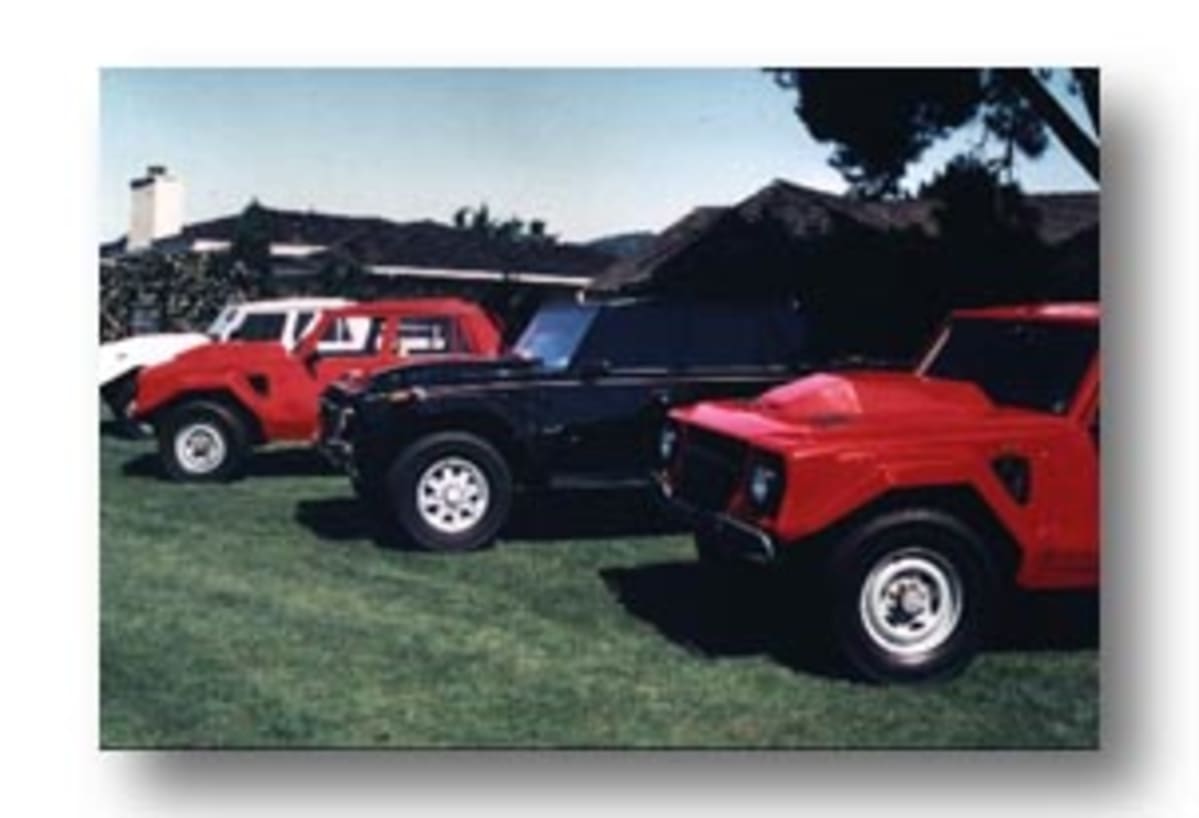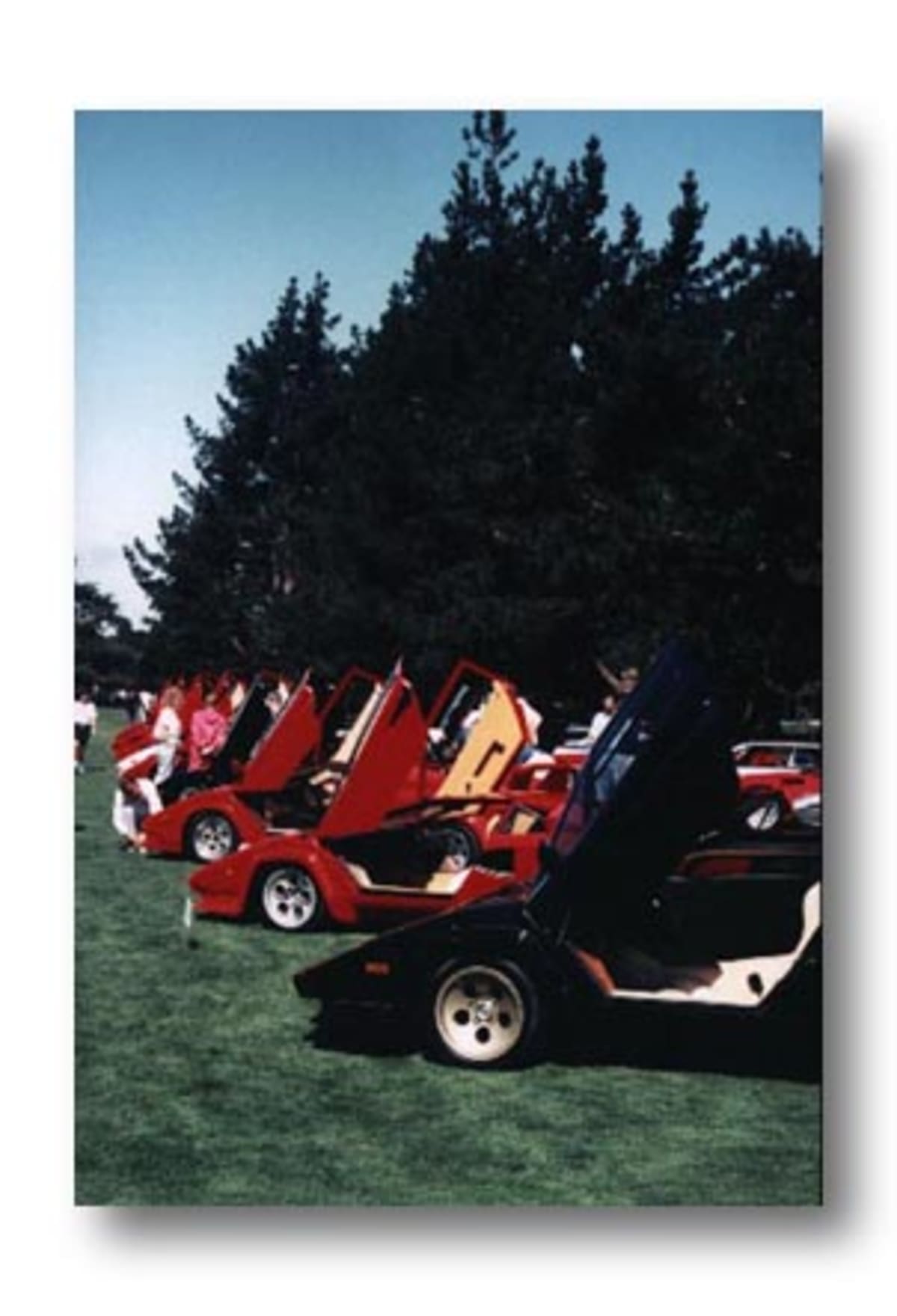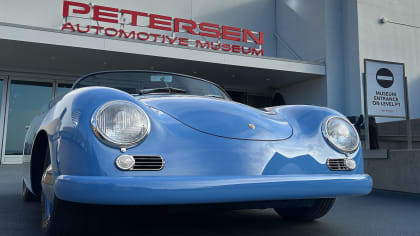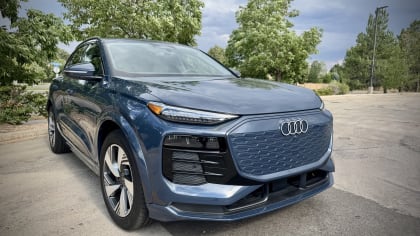Lambo Through the Looking Glass
Published on Wed, Jul 1, 1987
By: Len Frank
Lamborghini is an unlikely survivor. Competitors—Iso, Bizzarini, Facel-Vega, ATS, AC, Bristol, Jensen; earlier competitors like Bugatti, Pegaso, Talbot-Lago, Dual-Ghia (to mix a bag) are gone. The entire high-buck market seems increasingly to be the property of Mercedes and BMW, and, of course, Porsche and Ferrari.

In quick order: to the Geneva auto salon for two days; to Sicily to drive the old Targa Florio course in the new 16-valve Volvo, back to Frankfurt to pick up a 740 Turbo, over to Ashaffenburg to the Rosso-Bianco collection (about three hundred racing cars), up to Zurich to visit friends and the most prominent BMW/Veritas restorer in Europe, back to the Geneva salon, across the Alps to Turin to visit Lancia (and drive the 8.32 Ferrari-powered Thema), over to Modena (to the Fini Hotel)looking for Coco Chinetti, to the Maserati plant, the works proper, a conversation with Santiago De Tomaso (one part Charlie Chaplin, one part Giancarlo Gianinni, ten parts Alessandro De Tomaso), a ride and a drive in the new Maserati 430 and an encounter with the amazing Sr. Corghi, back to the Fini—still no Chinetti, then to look for the correct Sant Agata and Lamborghini itself. Yes.
I should explain about these press trips: journalists from the U.S. are gathered in Europe by the host, sheparded, coddled, watched over, cared for, hotels arranged, taxis paid for, itineraries checked and rechecked, wake up calls, passport reminders…in other words, a group of presumptive adults turn into effective juveniles complete with hall monitors and truant officers. When the trip is over, most of the press goes home. But I stay on without any of the oversight, and am immediately lost.
The problem was I was tired. And Agata seems to be a popular saint in Italy—I count five villages in my atlas with that name. And I know that it’s actually Sant Agata Bolognese, and that should put it near Bologna, right. But it’s really not all that close and it’s not the one near Imola either. And while Europe is generally a great place to be there are certain little components of civilization that are missing. Like all night coffee shops with bathrooms and motels with cheery “vacancy” signs lighting the night. Midnight. Discomfort. Pain. Weariness. Exhaustion.
The roads and the maps seem never to agree—the Italians have lived there since they were Romans so of course they know their way around—no need for street signs or even village names. Finally, I found, in a very dark village square, the polizia, who were rousting some shady looking types in a Fiat 131. Using both of my words of Italian and some expressive international arm-waving, I managed to communicate my need for a hotel—the location of Lamborghini was beyond the immediate vocabulary. The policemen motioned me to follow and we started a tour of the local hotels, complete with the police banging their trucheons on the hostelry doors and the keepers throwing open upstairs windows for a few minutes of neighborly threats and gesticulating. About the fourth stop, the charm worked and I had a room for the night.
The wonderful part though was that the innkeeper spoke very good English (rare outside of the big cities and not even all that common there) and knew exactly where Lamborghini was…about two kilometers away.

Another couple of explanations: the arranged press trips are just that—arranged. Naturally the manufacturers want the journalists to focus their attentions on the most positive facets, even if there aren’t many and all hell is breaking loose backstairs. So, with a vision of journalism born of too many B-movies (old trenchcoat, snap brim with press card in the band etc.), I started to drop in on factories unannounced. I got the chance to meet some very nice security guards, some very polite secretaries, but not much more. I finally stumbled onto Frank’s Golden Mean: call the international press guy (for the relevant company) back in the States from Europe. Doing it from a pay phone is best—the urgent sound of all of those zlotnys disappearing, combined with the inevitable static has a certain compelling urgency. The idea is then to get him to phone ahead by a few days at most so they know you’re coming but not exactly when. Here I am giving away all of my hard won secrets. A bonus.
Anyway, when I called John McCandless, late of AMC, now Chrysler’s International man, to tell him I was just down the road from Lambo (I was then actually in Turin), I could almost see him shift his cigar. I told him where I was and what I wanted to do. He gave me a phone number and hung up. Who let him in on the zlotny ploy? I called and got a pleasant lady on the phone who spoke better English than McCandless had lead me to believe. She said, Yes, come ahead, and No I couldn’t see Foghieri and the new F1 engine. And goodby.
After hours of being lost in the dark, a two minute drive and there it was. Another of those charming asides: have you ever noticed the little waterfall in the middle of the Olympia Beer logo–the one on all of their labels? The waterfall not only exists but it looks the same as it does on the label. However, if the camera, so to speak, were to pull out, there would be that little sylvan waterfall closely surrounded by heavy industrial sprawl, and Olympia’s slogan, “It’s the water,” takes on an entirely different meaning. The Lambo factory is a bit like that in reverse. It’s doubtful that any architect’s reputation will be made by having designed The Works, and further it rises up out of the absolutely flat farmland without any of Frank Lloyd Wright’s nonsense about buildings growing organically from their surroundings. Not a charming place. It is surrounded by a usually naked chain link fence but at this time, decorated with threats and strike posters. They were the kind of poster that one doesn’t have to be able to read to understand. Iacocca may be proud of his Italian parentage but the workers here have another view of that.
The lady I had talked with on the phone came to collect me for the factory tour. By U.S. standards she may have been a little overdressed for a factory tour, especially for 9am, but she snagged no ruffles, caught not one stiletto heel in the machinery, and also, though it may have been just familiarity (when were Italians ever diffident?), no one stared, whistled, or made rude Italian noises.
Lamborghini is an unlikely survivor. Competitors—Iso, Bizzarini, Facel-Vega, ATS, AC, Bristol, Jensen; earlier competitors like Bugatti, Pegaso, Talbot-Lago, Dual-Ghia (to mix a bag) are gone. Maserati, Lancia, Aston-Martin, are ghosts of the past. The entire high-buck market seems increasingly to be the property of Mercedes and BMW, and, of course, Porsche and Ferrari.
Ferruccio Lamborghini is supposed to have gone into the auto business after criticizing a Ferrari and being rebuffed by Enzo. It was a pretty slim reason. Ferrari had then (1963),and has now, a lock on the market. The original Lambo (350GT) was a brilliant design. Some later Lambos, the mid-engined Miuras especially, were landmark automobiles flawed by lack of development and cash for that development. Lamborghini’s biggest potential market—ours—was partially closed off by the requirements of the EPA/DOT which caused Lambo increasing problems. Their entry into the US coincided with the beginning of the US regs, the beginning of the end for them here.
Lamborghini, the company, went through crisis after crisis. Lamborghini, the man, long out of his original tractor business, got out of auto manufacturing and became a full-time vineyard owner and winemaker. It is rumored that he is part of the group producing the latest Bugatti revival. The company changed hands, went into economic limbo, the Italian government got involved, refused to let the ownership pass out of Italy. A deal to build cars for BMW eventually came to nothing. Bob Wallace, who did most of the hands-on development work, left and came to the U.S. to minister to the Lamborghinis, particularly the Miuras, that had gotten over here. The Countach replaced the Miura. The Jalpa, a very ugly car, replaced the Urraco and Silouhette—the latter three Lambo equivalents to the Dino and 208/308s from Ferrari. All these are random facts viewed from a distance; all painted a picture of a flaky, shaky operation continually tottering on the brink.
Add to all of the foregoing corporate history the US customer body, such as it was. Lamborghini seemed to appeal most to those who might own a Clenet or an Excaliber as a second car (after a “Designer Mark” Lincoln or a Rolls-Royce), those who progressed directly from an El Dorado to a Countach. If 308 buyers were from the Gucci-and-gold crowd chain, Lambo buyers couldn’t tell real Gucci from fake, and kept tangling their baroque jewelry in the Countach’s stubby shift lever. Lambos were strictly grey market, poseur, noveau. And the dealers were worse. The implication here, if I have not made myself clear, is that the cars were as undesirable as the owners and dealers.
On paper, most Lamborghinis have been sensational cars—the big ones are 4-cam V-12s (the latest Countach with four valves per cylinder) with Lambo-built gearboxes (Maserati, for example, buys ZF) and bodies designed by Scaglione, Giugiaro, and, unfortunately, Gandini (Jalpa). The Countach was always included in those spurious magazine lists of the world’s fastest cars, and usually broke down on the way to the track.
Then came Uncle Lido and The New Chrysler Corporation. The US government required Chrysler to divest itself of anything that might divert it from building and selling cars before it would underwrite the Chrysler loans. As soon as Chrysler was out from under that edict, and there was cash to do so, Chrysler began to reacquire. Iacocca renewed his business dealings with De Tomaso (anyone remember the Dodge De Tomaso Charger?) and seems to be inheriting Maserati. Then, after GM bought Lotus out from under Toyota’s nose, without breaking stride, Chrysler bought Lamborghini and announced that it was going to sell North American-built cars in Europe, despite lack of suitability and dealers, and, oh yes, they were going to build an F1 engine. And they would, probably, sell Lambos in the US. The whole thing had the smell of cordite around it from all the hip-shooting that went on.
There was a lot of snickering about Countach bodies on K-car chassis, and V-12s composed of a pair of slant sixes. So there I was, finally to see for myself, and there were those stike posters on the fence…
Surprize. To give it all away at the start, everything looks terrific. Used to seeing specialty car plants with dirt floors populated by Troglodytes in England, filthy enterprises run under abysmal conditions in France, slightly mad iconoclasts in Germany, and the whole repeated in Italy with comic opera overtones, Lamborghini is impressive (the aforementioned enterprises do not include Ferrari or AMG and a few others). The Lambo plant is very clean, well equipped, pretty well laid out, appears to be well staffed. There are lines for the Countach, the Jalpa, the utility supercar LM002, and some marine V-12 production. Quality and care are evident everywhere. No embarrassments in dark corners, but I kept looking.
The strike posters, I was told, were not really strike posters, but part of the usual semi-annual contract negotiation process. After a couple of hours of wandering through the plant, I spoke, mainly with Carl Levy, acting managing director. Levy, an American, spent 25 years with Ford of Europe, then International-Harvestor, then into what he thought was going to be retirement. When Lambo Managing Director Emile Novarro was hurt in an accident (“…nothing to do with the posters…it was a car.”) Levy stepped in temporarily. Lamborghini was obviously a long stretch from the Ford Fiesta that had occupied a large chunk of his working life, but he seemed to me enjoying himself.

The former owners, brothers Patrick and Jean-Claude Mimram, were running quickly out of money. Plant maintenance had slowed, quality had slipped. Chrysler is supposed to have paid twenty-odd million dollars (forty has also been mentioned—either figure would be a bargain) for the locks, the stocks, the barrels. Levy, friendly, balding, talkative, perhaps late fifties, recounting the first days, waved his hand at the office window and said that the “…grass and weeds were ten feet high out there…it was breaking even when Chrysler bought it, but just…” The Mimrams had bought it out of bankruptcy. Income for 1987 was 38,575,000,000 lira. Did I get that right? Thirty million dollars, depending on the exchange rate.
Buying Lamborghini seemed to have been Gerald Greenwald’s (Chairman, Chrysler Motors) idea but I can’t help but think that Iacocca must have favored it from the beginning. Owning Lambo bespeaks great style. The idea is to make it into “a viable Ferrari competitor…no plans,” said Levy, ” for including expansion…maybe just build up production to about 50% of Ferrari’s.”
I had earlier talked with Molinari who, among his hats, wears the PR fedora. Production, he told me, was one car a day for Countach, one Jalpa every three days, plus of course the bizarre-looking LM002 now being readied for sale in the US (Since it’s a utility vehicle instead of a passenger car, fewer US restrictions apply.). Soon Chrysler will work on setting up a sales network (“…maybe about 10 dealers.” Levy). Chrysler owns distribution rights for the cars in the US, despite claims from others.
Plans: a new car to replace the Jalpa by 1991 with a production of ten a day. Increase production of the Countach to three a day. “A possibility, in Modena…” Molinari talking “…where Fogieri makes the F1 engine, to produce a style center for Chrysler-Lamborghini. Foghieri doesn’t tell us much (about the F1 engine)…80o V-12 is all I know…not yet ready for dyno runs. It will cost eventually, $20,000,000 (The Cosworth DFV cost Ford about $280,000 in 1966).
Molinari again:”We intend to do something (about the aging Countach), but not this year…Bugatti will have a similar car, Ferrari of course…we modify the Countach a little bit every year, otherwise the owners are not so easy to get.”
Each Countach is sold before it ever starts production. The frames are from an outside supplier, as are the body panels (LM002 bodies are from Spain), most castings and forgings, wheels…Levy:”A big mistake to buy up suppliers…Lamborghini is based on artisan suppliers.”
Chrysler, Levy says, will supply sales discipline “…something US companies are good at, and something lacking at Lamborghini.” As the price of exotica escalates, new techniques and markets will have to be found “…a big difference,” he says, “between $70,000 and $100,000.” Indeed. “And come back when there are some unsold cars to drive.” I’ll try. I’ll force myself.
After talking with Levy and Molinari, the nice lady, actually Molinari’s secretary, lead me back out and clacked off on those high, high, heels. It certainly wouldn’t have been possible at Mercedes, but instead of turning left to the Volvo, I turned right and wandered back around the building. No one had mentioned the restoration shop. It was full and busy. They had just rolled a glorious metallic blue Miura out into the bright sunlight. A real feast. I continued around back. An LM002 rumbled by. Ironically, when the LM002 was designed as a quasi-military vehicle for the oil rich (armor-plate optional), it used a Chrysler V-8.
Behind the plant is a junk heap and on the top of the heap is a prototype, a variation on the Espada, just waiting for some collector, uttering little shrieks of joy, to rescue it. Collectors are not much understood by any of the US companies. Behind that is a long shed roof without walls and under that is the damndest collection of old Lambos on the face of the earth. Every model seems to be represented including the ultra-rare Jota, a kind of racer version of the Miura. They appear to be waiting their turn in the restoration shop, or considering the US Lambo experience, perhaps to have been repossessed. I’ll take the Jota, please.
Top image: 1969 Lamborghini Miura P400-S (WallpaperUP Public Domain)

The late Len Frank was the legendary co-host of “The Car Show”—the first and longest-running automotive broadcast program on the airwaves. Len was also a highly regarded journalist, having served in editorial roles with Motor Trend, Sports Car Graphic, Popular Mechanics, and a number of other publications. LA Car is proud to once again host “Look Down the Road – The Writings of Len Frank” within its pages. Special thanks to another long-time automotive journalist, Matt Stone, who has been serving as the curator of Len Frank’s archives since his passing in 1996 at the age of 60. During the next few months, we will be re-posting the entire collection of “Look Down the Road”, and you’ll be able to view them all in one location under the simple search term “Len Frank”. – Roy Nakano




